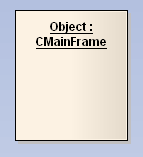
An Object is a particular instance of a Class at run time. For example a car with the license plate AAA-001 is an instance of the general class of cars with a license plate number attribute. Objects are often used in analysis to represent the numerous artifacts and items that exist in any business, such as pieces of paper, faxes and information. To model the varying behavior of Objects at run-time, use run-time states.
Early in analysis, Objects can be used to quickly capture all the things that are of relevance within the system domain, in an Object, Composite Structure or Communication diagram. As the model progresses these analysis Objects are refined into generic Classes from which instances can be derived to represent common business items. Once Classes are defined, Objects can be typed; that is they can have a classifier set that indicates their base type. See Set Instance Classifier.

Toolbox Icon
![]()
OMG UML Specification
The OMG UML specification states:
"An object represents a particular instance of a class. It has identity and attribute values. A similar notation also represents a role within a collaboration because roles have instance-like characteristics."


